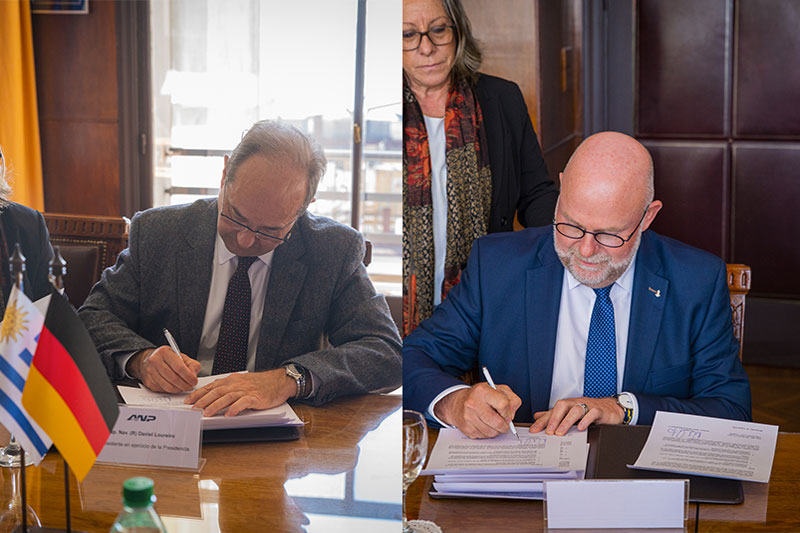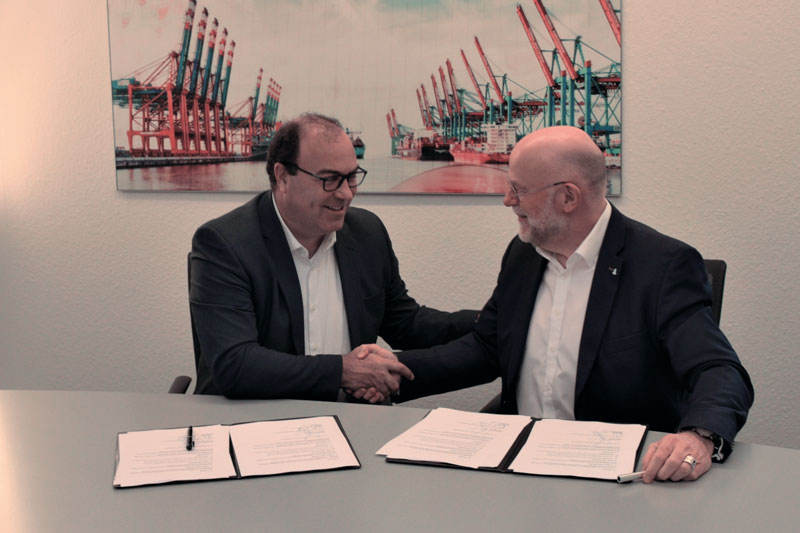“India could become one of the upcoming countries”
Dr. Vincent Stamer is a foreign trade expert at the Kiel-based Institute for the World Economy and also the creator of the Kiel Trade ...

Uruguay and Canada also aim to position themselves there. Hamburg has accordingly signed basic agreements covering cooperation with the ports in Montevideo, Uruguay and Belledune, Canada.
The sea links the Port of Hamburg with more than 1,000 ports worldwide. Those include the Port of Montevideo, capital of the South American country of Uruguay. This small nation, lying roughly speaking between Argentina and Brazil, and accessible by ship across the South Atlantic, is seen as one of Latin America’s most stable, democratic, and prosperous countries. Happy to be termed a model, this state has managed to position itself as a strategic transit point for international trade. Along with Chile, it is the South American country with the most sophisticated port infrastructure. Montevideo is seen as the most import commercial port on the East coast of South America. The Ports of Hamburg and Montevideo have been cooperating for many years. They signed a first Memorandum of Understanding in 2005, renewed in 2013. Signed last August, the third declaration of intent provided for an intensification of cooperation on hinterland transport, intelligent ports, and green hydrogen. Montevideo’s port is meanwhile seen as an energy hub, proclaiming itself as set to play a central part in importing and exporting renewable energies.


“The Port of Hamburg offers Uruguay access to Germany and Europe, and has for many years been a valued partner for knowhow transfer and expansion of commercial links,” says Franziska Gruber, Head of Services, Foreign Trade and Sustainability Department of the Montevideo-based German-Uruguayan Chamber of Industry and Commerce. Especially in the build-up of an international hydrogen economy, in which Uruguay seeks to position itself as a supplier of climate-friendly energy sources, cooperation with the Port of Hamburg will be of great importance. Given the agreement with the EU, as a freeport and gateway to the international trading organization Mercosur in Latin America, the Port of Montevideo will in future offer enhanced access to trade flows from and into this economic bloc.
Uruguay already produces 97 percent on average of its energy needs now from renewable sources. The country’s Hydrogen Roadmap to 2030 indicates that it will be producing an additional ten gigawatts of green hydrogen, mainly for export. “Cooperation between the two ports on energy questions, plus knowhow transfer, are reflected in additional partnerships in the public and private sectors, producing a win-win situation for the two countries,” adds Gruber. “The Ports of Hamburg and Montevideo can contribute towards the transport of green energy from South America to Europe,” emphasized Dr Peter Tschentscher, First Mayor of the Free and Hanseatic City of Hamburg, at the signature of the MoU in 2022.
“Along with already existing business, we are looking at the idea of exchanging experience with the Port of Hamburg and seeing which tools utilized there could be useful for the Montevideo port area,” added Andrés Nieto, National System Ports Area Manager of the ANP, Uruguay’s national port authority. Consideration is also being given to the possibility of making the Port of Montevideo available, not simply for Uruguayan imports and exports, but also to such countries as Paraguay and Bolivia, which have no seaports, for theirs. “And Uruguay will be investing about 1.9 billion euros in developing green hydrogen by 2040. Being situated so close to the Atlantic, the Port of Montevideo is ideal for exporting,” he says. The country began to develop alternative energies in the years after 2010, mainly working with a mix of solar, water and wind power. This facilitated production of a large quantity of green hydrogen. Uruguay could play a key role as a supplier of renewable energy sources. In addition, it possesses production capacities that could cover future German demand for methanol. This could be of special importance for decarbonizing the chemical industry.
Back in 2020, AHK Uruguay, along with the German embassy in Montevideo and several German companies, launched an initiative for supplying Germany with green hydrogen. One of the firms behind the initiative was Enertrag, which is developing Uruguay’s first export project with the Tambor Green Hydrogen Hub in Tacuaremboin in the centre of the north of the country. In foreign trade, moreover, Germany is Uruguay’s most important partner in Europe, taking sixth place in the Uruguayan trading statistics. The main German imports from there are cellulose, beef, wool and textiles. Germany exports chiefly pharmaceuticals, vehicles, automotive parts, and chemicals to Uruguay.
Germany also seeks to cooperate more closely with Canada on hydrogen. The Canadian and German governments have agreed to create an energy partnership. The aim of this is for both countries to achieve zero-net emissions, thus implementing the Paris climate treaty endorsed by both Canada and Germany. They also back the joint Declaration of Intent signed between Germany and Canada in 2022 in Stephenville, Newfoundland in August 2022. This provided for the launch of the German-Canadian hydrogen alliance.
To ensure safe and secure access for the transport of clean fuels, green energy, and other products between the two countries, the BPA – Belledune Port Authority in Canada and the Port of Hamburg signed a declaration of intent in December 2022. The two ports wish to cooperate on the carriage of dry and liquid bulk cargoes and industrial products. The emphasis there is on the production, storage and transport of environment-friendly fuels such as green ammonia, biomass, and renewable natural gas. The Port of Belledune lies on the Atlantic and offers some of the shortest sea transport routes to Europe. It offers four deepsea terminals, an industrial zone covering 1,600 hectares, and state-of-the-art infrastructure.
Via the Canadian Fednav shipping company with its Atlantic Lakes line ‘FAL Line’ service, since the beginning of April the Port of Hamburg has also been directly linked with the Great Lakes, a group of five conjoined freshwater lakes in North America. Hamilton in Canada and Cleveland in den USA are among the overseas destinations. As the first so-called ‘laker,’ the ‘Federal Oshima,’ with a displacement of 36,000 tons, calls in Hamburg at Terminal C. Steinweg. Fednav operates a fleet of around 120 bulk carriers, sailing worldwide, of which the company owns around 60. Fednav is based in Montreal, employs about 300 office staff, and operates trading offices worldwide. “This new service indicates that we are seeing growing diversification of lines,” says Axel Mattern, CEO of Port of Hamburg Marketing. Additional liner services listed in the Port of Hamburg during the first quarter underline this trend. In February, for instance, the Peter W. Lampke shipping company as the German representative of Ellermann City Liners added Hamburg to the transatlantic USX line. Five ships with capacities of up to 5,000 TEU ply between Hamburg, Tilbury, New York, Jacksonville, Wilmington, Bilbao, Antwerp, and Rotterdam, linking Hamburg directly with the US East coast.
“The USA trade was always the classic route for every shipbroker or liner agent with long-standing Hanseatic ties,” explains Andree Brinkmann, CEO of PWL Shipping. With its new agency for Ellerman City Liners of Britain, the company is seen as one of the last ‘independent liner agents’ in Germany in the full container trade with the USA. “Our experience as an independent shipbroker and a privately-run company in the US trade have for several years also extended to the RoRo liner shipping companies representing PWL Shipping between German ports and the USA,” he explains. The shipowner has so far as a rule transported high-grade consumer and industrial goods from renowned manufacturers in Germany, Austria, and Switzerland, as well as Poland and Czechia, among other countries. The weekly sailings are from HHLA’s CTB – Container Terminal Burchardkai.